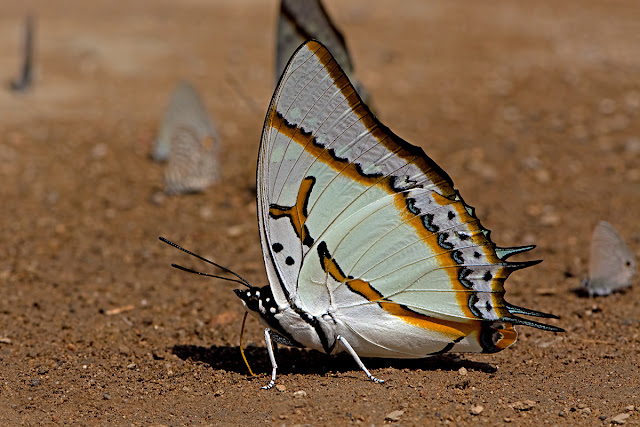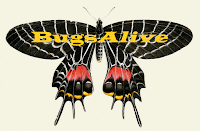Polyura eudamippus - the Great Nawab
Written and photographed by Tim Stratford
 |
| Ob Khan National Park, Chiang Mai, Thailand. 360m a.s.l. |
Introduction
Family: Nymphalidae - Subfamily: Charaxinae - Genus: Polyura - Species: eudamippus
Polyura eudamippus is a large and beautiful butterfly with a wingspan of 75-120mm with the female being considerably larger than the male. Apart from the size, both sexes look very similar and are easily distinguishable from other look-alike species by the Y-shape end to the yellow central band on the underside of the wings. Although they spend much of their time flying around the tree tops they do come down to feed and, like other Charaxinae species do not usually visit flowers, preferring instead the delights of animal dung, tree sap, and rotting fruit. The males are also avid mud puddlers, sucking up minerals to pass on as a kind of gift to females when mating. When the males are feeding they are almost oblivious to humans and make good photographic models. When this species settles it usually closes its wings and only rarely opens them to bask in the sun.
Distribution & Seasonality
Distribution stretches from northern India in the west via Nepal, Bhutan, Myanmar, Thailand, Laos, and Vietnam to southern China in the east, and also venturing as far south as peninsular Malaysia. They fly for a large part of the year, exact months depending on location, and are multivoltine producing several generations each year. There appears not to be any seasonal variation in the visual appearance of this species. Habitat is low altitude hilly evergreen forest, usually near streams.
Family: Nymphalidae - Subfamily: Charaxinae - Genus: Polyura - Species: eudamippus
Polyura eudamippus is a large and beautiful butterfly with a wingspan of 75-120mm with the female being considerably larger than the male. Apart from the size, both sexes look very similar and are easily distinguishable from other look-alike species by the Y-shape end to the yellow central band on the underside of the wings. Although they spend much of their time flying around the tree tops they do come down to feed and, like other Charaxinae species do not usually visit flowers, preferring instead the delights of animal dung, tree sap, and rotting fruit. The males are also avid mud puddlers, sucking up minerals to pass on as a kind of gift to females when mating. When the males are feeding they are almost oblivious to humans and make good photographic models. When this species settles it usually closes its wings and only rarely opens them to bask in the sun.
Distribution & Seasonality
Distribution stretches from northern India in the west via Nepal, Bhutan, Myanmar, Thailand, Laos, and Vietnam to southern China in the east, and also venturing as far south as peninsular Malaysia. They fly for a large part of the year, exact months depending on location, and are multivoltine producing several generations each year. There appears not to be any seasonal variation in the visual appearance of this species. Habitat is low altitude hilly evergreen forest, usually near streams.
Lifecycle
The lifecycle of this species is not fully known and further research is needed. The adult female probably behaves similarly to other Charaxinae and lays her eggs singly in small batches on the upper surface of a leaf of the host plant. The eggs are dome-shaped and pale yellow in colour. They hatch after 3 to 5 days and the larvae are very distinctive being bright green in colour with 4 'horns' on their heads, making them look rather dragon-like. They also have a studded pale yellow 'saddle' on the thorax. There are five larval instars with the first instar lasting 7 days and reaching a maximum length of 7mm. By the time it munches its way through to the final instar it is up to 63mm in length. Pupation usually takes place on a twig or stem with the larva sometimes leaving its host plant to do so. The pupa looks similar to other Polyura species. The duration of the final larval and pupal stages is not known as far as I am aware.
The total time from egg to adult is not fully known but is likely to be around 45-60 days. The duration of each known stage is as follows. All figures are approximate :-
- Egg : 3-5 days
- Instar 1 : 7 days
- Instar 2 : 7 days
- Instar 3 : 4 days
- Instar 4 : 9 days
- Instar 5 : ? days
- Pupa : ? days
Host Plants
Known larval host plants are Rhamnella franguloides, Rhamnella inaequilatera (Rhamnaceae), Celtis boninensis (Ulmaceae), Archidendron lucidum, Caesalpinia crista, Cassia bakeriana, Delonix regia, Millettia reticulata, Wisteria floribunda (Fabaceae), and Filicium decipiens (Sapindaceae).





